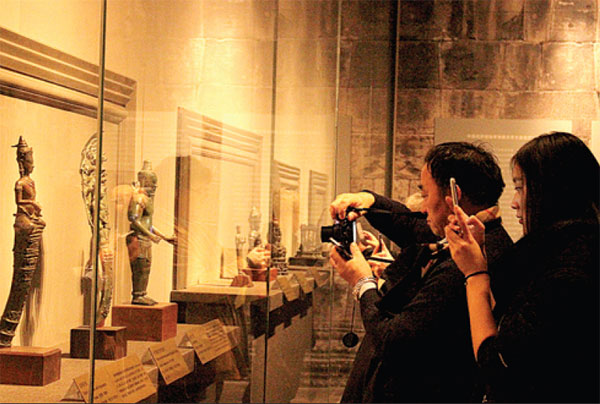See Angkor Wat in China at major museum shows
Updated: 2014-12-30 07:13
By Wang Kaihao(China Daily)
|
|||||||||||
You will soon be able to see parts of Cambodia's landmark Angkor Wat temple in Beijing.
Following yearlong preparations, Cambodia's first major exhibition of its cultural relics in China has opened at the Capital Museum on Friday and will continue through March 25.
After Beijing, the Smile of Khmer: Cambodian Ancient Cultural Relics and Art will move to Guangzhou in southern China's Guangdong province in April.
Some 80 pieces, including stone statues, bronze wares and ceramics, are part of the upcoming display at Beijing's Capital Museum.
The exhibits that otherwise are housed at the National Museum of Cambodia offers glimpses of the Khmer Empire from the 9th to 15th centuries, officials say.
Inside a hall of the Capital Museum, mood lighting over the exhibits also mimics facades and the environment of the ancient, sacred Cambodian architecture.
"We don't want the exhibition to be very serious," Tang Yisong, president of Beijing Huaxie Cultural Development Co Ltd, the main curator of the exhibition, tells China Daily.
"That's why we traveled to Angkor Wat many times to get enough information to mimic the environment."

The exhibition is intended to display the relevant backgrounds from Hinduism and Buddhism that greatly influenced the Angkor civilization.
According to Tang, a 7th - or 8th-century stone statue of Ganesh, who is a key Hindu deity; a 9th-century antefix depicting a rishi, or Hindu sage, in prayer; and an 11th-century statue of the Buddha seated on Naga (the serpent deity) are among the show's highlights.
As Chinese porcelain became popular in Southeast Asia during the Song Dynasty (960-1279), the techniques of making Chinese porcelain were also exported to Cambodia.
Some exhibits at the show bear testimony to that exchange between the two countries, the curator says.
According to Chuch Pheourn, secretary of state of Cambodia's Ministry of Culture and Fine Arts, the earliest records of Chinese manuscripts in Cambodia can be traced to the period between 100 BC and AD 100, during China's Han Dynasty (206 BC-AD 220).
In addition, Khmer Buddhist monks made frequent visits to China in the 6th century.
In 1296, Zhou Daguan, a diplomat from China's Yuan Dyansty (1271-1368) arrived in Cambodia, and later wrote The Customs of Cambodia, the world's only surviving first-person written account of daily life in the Khmer Empire.
It remains one of the most significant historical records of Angkor Wat from the time.
"I am confident that this (the exhibition) will bring more attention to the Khmer heritage and the monuments outside the Angkor complex," Pheourn says.
"It will enhance Chinese understanding of Cambodia's history and culture, and promote cultural tourism in Cambodia."
"The exhibition is more than a visual delight for regular museum visitors," says Gu Yucai, deputy director of China's State Administration of Cultural Heritage.
"It will provide a precious opportunity to the two countries' scholars on the history of religions and fine arts to exchange ideas as well."
Cambodia's government and UNESCO jointly launched a campaign to rescue Angkor Wat in 1993. Gu's administration first sent a panel of experts to study the World Heritage site in 1996 and began a long-term ongoing cooperative project to renovate and protect the Khmer cultural site.
"The conservation of Angkor is China's first official international cooperation in terms of cultural heritage," Gu says.
"Chinese cultural heritage professionals have not only made their contributions to the restoration of Angkor but also gained systematic knowledge of Cambodia's culture and history as well as the various concepts and technologies to protect cultural heritage worldwide, which greatly boosted our own capacity in the field."
wangkaihao@chinadaily.com.cn
|
The Smile of Khmer: Cambodian Ancient Cultural Relics and Art exhibition gives Beijing visitors deeper insight into the ancient Angkor heritage. Photos by Wang Kaihao / China Daily |
(China Daily 12/30/2014 page19)
Today's Top News
Missing AirAsia plane maybe 'at sea bottom'
More than 200 evacuated from buring Italian ferry
Aviation's deadly 2014, yet safety record improving
Albania takes part in rescue efforts on burning Italian-flagged ferry
Debate on largest economy pointless
China to ease investment rules in FTZ
China to add over 13 million jobs in 2014
Beijing eyes 5% drop in PM2.5
Hot Topics
Lunar probe , China growth forecasts, Emission rules get tougher, China seen through 'colored lens', International board,
Editor's Picks

|

|

|

|

|

|






